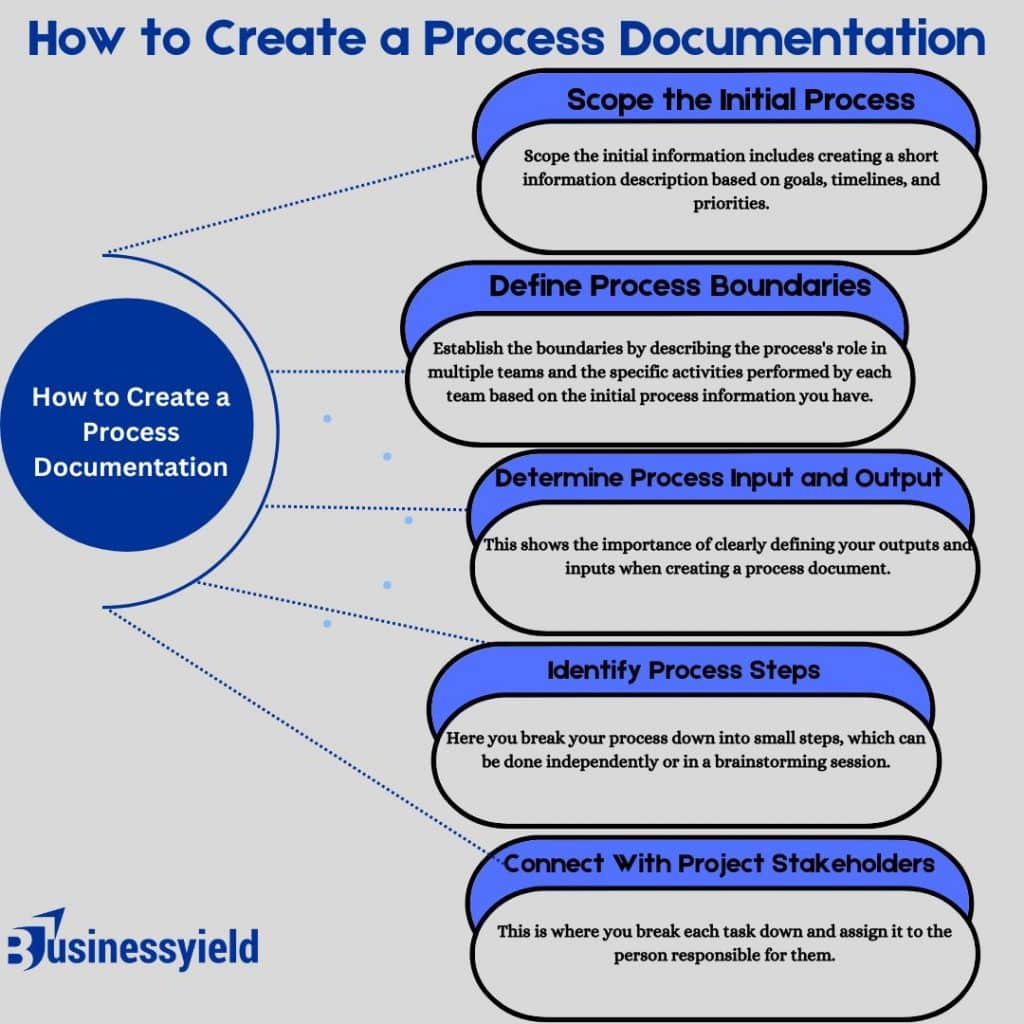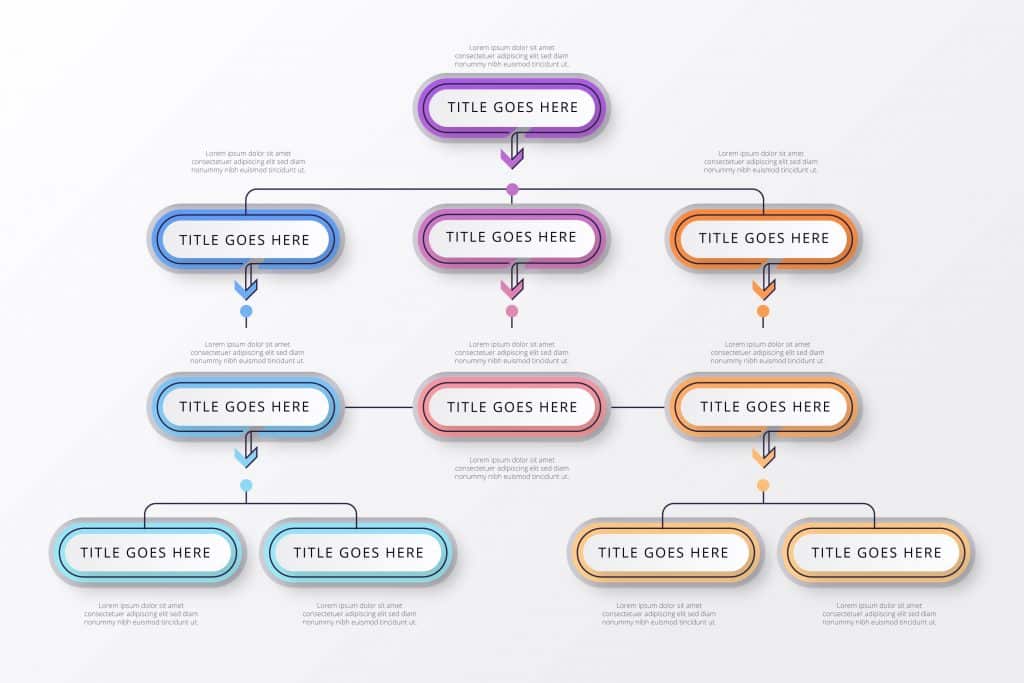During the time of the COVID-19 pandemic, everything went upside down. The pandemic affected some businesses, forcing people to start working remotely. Such a situation shows how important it is for companies to be able to adapt and change quickly. During this time, I had to adapt to a new method of working overnight because other staff and I were provided with process documentation that stated how to adapt to situations like that.
The company I worked for then had a process document that helped me stay on track during those tough times. I remember the other staff and I worked from home, and meetings were held online. I learned the importance of adapting to new working methods, even hard ones. Moreover, process documentation is a key part of project management. It is a guide that states how things are done in your business. Furthermore, I will walk you through the meaning of process documentation, its types, and examples.
Key Points
- Process documentation is a living document with details of tasks and steps needed to launch a new process. It streamlines and improves your operational procedures.
- Process documentation serves as a step-by-step tutorial to eradicate confusion and as a reference for team members to complete their tasks effectively.
- The steps to follow when creating process documentation include scoping the initial process, defining process boundaries, determining process input and output, identifying process steps, and connecting with project stakeholders.
- Checklists, performance reviews, service delivery processes, case studies, tutorials, and forms are examples of process documentation.
- Types of process documentation include flowcharts, spaghetti diagrams, process maps, and swimlane diagrams.
Process Documentation
This is a living document with details of the tasks and steps needed to launch a new process. Developing process documentation is needed for something as simple as recruiting new hires to bigger goals like changing team structure. It is critical to track the progress of these new processes. Process documentation streamlines and improves your operational procedures. Aside from keeping teams organized, process documentation acts as a road map for staff workers, assisting in learning the steps needed to construct the correct procedure.
As a business writer and consultant, I have witnessed different kinds of clients who had setbacks that they wished to overcome to achieve growth and success. I remember working with a family that owned a restaurant they wished to expand. I applied process documentation in collaboration with the owners to develop a comprehensive inventory management system. Apart from developing a clear process for ordering and tracking, it also reduces waste and optimizes efficiency. This taught me the power of process documentation in business operations. In addition, process documentation serves as a step-by-step tutorial to eradicate confusion and as a reference for team members to complete their tasks effectively. The supporting documents that may be included in this process documentation are:
- Case studies
- Checklist
- Forms
- Policies
- Process map
- Screenshots
- Tutorials
Read Also: How to Transition from Offline to Online When It Comes to Your Business and Its Processes
How to Create a Process Documentation
The following are the steps to follow when creating a process document: Every phase aims to identify areas for improvement and increased productivity. I will enlighten you on these steps.

#1. Scope the Initial Process
First, the project manager scopes the initial information. The manager creates a short information description based on goals, timelines, and priorities. You accomplish this by examining and documenting the objectives in a business case. The following are process scope that must be included:
- Key objectives: Think about the key performance indicators or business objectives your process wants to achieve.
- Stakeholders: Consider the teams that will be working together, even if you don’t know the specific individuals yet
- Timeline: You can estimate the length of the process and its expected completion time.
- Priority: Decide the importance of implementing this process and compare it to other projects and objectives your team is working on. These factors give stakeholders and the leadership team a clear picture of the process.
#2. Define Process Boundaries
You can now establish the boundaries by describing the process’s role in multiple teams and the specific activities performed by each team based on the initial process information you have. Consider both the start and the end of the process, as well as the people who will be impacted by it. I recall a significant scenario where I worked with a client who needed to streamline their content creation process. This company is still growing and has multiple teams involved in content development, including writers, editors, designers, and marketing specialists. I and the team first mapped out the entire content creation journey from ideation to publication while defining the process boundaries. My team also outlined the tasks of each team involved. Ultimately, I witnessed how this approach improved content quality and reduced production time.
#3. Determine Process Input and Output
This step is about identifying the inputs and outputs. Another difference between process input and output is that the former refers to the resources needed to carry out the process and the latter to the desired outcome at its conclusion. I remember some time ago when I tackled a project to improve a client’s social media strategy. I started by defining the input and output of the process. These inputs, such as market research, competitor analysis, and accessing the client’s branding guidelines, were essential to complete the process effectively. As for the outputs, we clarified our goal of gaining a more engaging social media presence. This task showed me the importance of clearly defining your outputs and inputs when creating a process document.
#4. Identify Process Steps
After gathering information through process inputs and outputs, you now break your process down into small steps, which can be done independently or in a brainstorming session. A month ago, I was tasked with developing a content creation process for my client’s marketing campaign. I identified the process steps by breaking down the content creation journey into smaller, more manageable steps that can be completed independently. First, I outlined the key stages of the process, for example, ideation, research, drafting, editing, and finalizing. Afterward, I divided each stage into tasks such as conducting keyword research, outlining the content, writing the first draft, and amending based on feedback. This experience helped me to organize and understand the importance of flexibility and collaboration among team members.
#5. Connect With Project Stakeholders
This is where you break each task down and assign it to the person responsible for it. You can include detailed information for easy tasks in the document, such as deliverables and timelines. I recommend that you meet the team if you need to provide additional task background or context for complex projects.
In addition, other steps include constructing a process flow chat, note the process flow exceptions, and testhe process.
Read Also: STEPS IN THE HIRING PROCESS: A Guide For HR Managers
Process Documentation Examples
Process documentation is important for integrating team members into the company culture and providing them with the necessary tools. A checklist is a simple document that lists the steps required to complete a task. While creating a checklist on Standard operations procedures, I will help understand the examples of process documentation. However, before creating a checklist on SOPs, let’s understand what it is.
Standard operations procedures are documents detailed enough to outline the steps needed to perform a particular task or process. Also, they are used to ensure consistency in how you complete tasks, which is often used in industries like healthcare, manufacturing, and IT. Here is a checklist of standard operating procedures to enhance your understanding of process documentation examples.
Standard Operating Procedures Checklist
Types of Process Documentation
Process documentation describes how to execute a process, but choosing the right format is important to keep your guides effective and easy to understand. The following are the presentation types of process documentation:
Flowcharts

Flowcharts are presented as diagrams known for process documentation because they are versatile and easy to use. Furthermore, you can use this format for any process, from product design to administrative processes. Thus, they consist of shapes connected by lines or arrows to show the process’s flow. This is one of the types of process documentation that helps employees understand the correct instructions for performing each task. Besides, as a brand consultant, I have often utilized flowcharts as a process documentation. I used it to help an e-commerce startup improve its customer support process. Also, I created a simple flowchart and outlined the steps from receiving the query to resolving it. Consequently, the visual guide is crucial for training new staff members and ensuring consistency in handling customer queries.
Spaghetti Diagram

This is one of the types of process documentation known as the spaghetti model because it is made of different noodles that link a series of steps. This format is useful for showing how the tasks in a process interact. Some time ago, when I was working on a content marketing project, I used the spaghetti diagram to visualize the content creation process, where each step was represented by a noodle, and the line between the noodles showed the flow of tasks and information. Using this format helped the team and me redesign the workflow, eliminating layoffs and improving collaboration between team members.
Process Maps

This is one of the types of process documentation that brings clarity by breaking down the processes into smaller sections. It divides a project into different stages and allows you to see how different factors on each page can affect your work. As a business writer and consultant, I often use process maps to help my clients streamline their operations and improve efficiency. I recall working with a manufacturing company called ” KolStian Groups,” where I created a process map to visualize their product lotion flow. To achieve that, I broke down the manufacturing process into smaller stages, and the map revealed inefficiencies and areas in the company that needed improvement. It also helped my client understand the factors affecting overall production at each stage. This insight has sincerely assisted KolStian groups in making informed resource allocation and process optimization decisions.
Swimlane Diagrams

I have once been tasked with improving the effectiveness of a client supply chain process. This involves documenting the complex interactions between procurement, inventory management, and logistics teams. While I opted for the swimlane diagram, it visually represented the roles of different teams and how their action affected other parts of the supply chain. This format replaces lengthy written processes and provides a clear view of the entire chain workflow. This process is good for organizations with many functions and cross-functional teams because it shows what needs to be done, how it should happen, and who does it.
Read Also: JOB ANALYSIS: Effective Methods for Job Analysis (+Process and Purpose)
What Is the Difference Between Product Documentation and Process Documentation?
The difference is that process documentation records the process documentation for development, while product documentation describes the developed product.
How Do You Write a Good Process Document?
- Scope the initial process
- Define process boundaries
- Determine process inputs and outputs
- Identify process steps
- Connect with project stakeholders
- Constrict a process flowchart
- Note process flow exceptions
- Test the process
What Is the Standard Format for Process Documentation?
- Set a foundation and scope.
- Set the process parameter.
- Identify process resources and objectives.
- Break the process into actionable steps.
- Assign roles and responsibilities.
- Develop Key Performance Indicators (KPIs) …
- Test and refine the process. …
- Implement and train employees.
Why Do We Need Process Documentation?
We need process documentation for:
- Clarity and consistency
- Training and onboarding
- Efficiency and productivity
- Risk management
- Continuous improvement
- Knowledge management
- Communication and Collaboration






